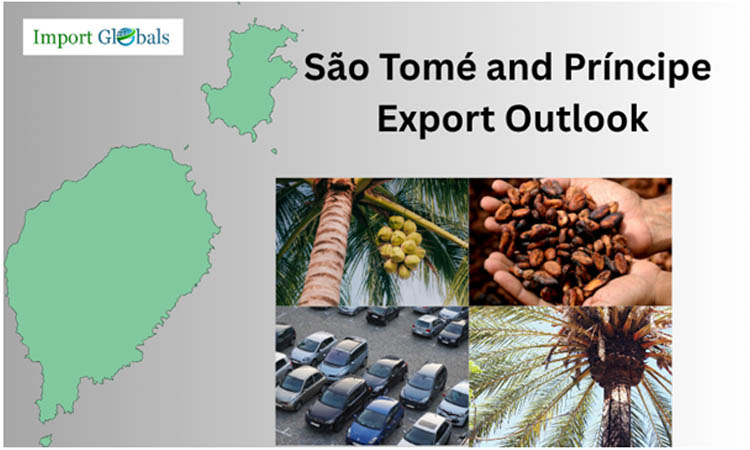
- Jul 15, 2025
São Tomé and Príncipe Export Outlook: Economic Trends, Key Markets, and Strategic Growth Pathways
Agriculture and trade are the main drivers of the nation's economy, despite its small population and small geographic area. According to Import Globals' São Tomé and Príncipe Import Data, the export economy of the country has traditionally been built on cocoa, palm oil, and items derived from coconuts. To maintain long-term economic stability, São Tomé has taken action in recent years to diversify its export base, promote foreign investment, and upgrade its infrastructure.
The country has a geographical advantage due to its advantageous placement along West African trade routes, and its administration is putting more effort into growing export earnings through better market access and trade alliances. With the growing demand for sustainable and organic products worldwide, São Tomé and Príncipe has the potential to emerge as a major player in specialized agricultural markets, according to São Tomé and Príncipe Export Data by Import Globals. This blog examines the nation's export performance between 2020 and 2024, taking into account economic indicators, important export markets, product categories, and anticipated changes that may influence its future in global commerce.
General Economy Overview of São Tomé
The modest, open economy of São Tomé and Príncipe is largely reliant on external commerce, donor aid, and agriculture. About 90% of the nation's traditional exports are made from cocoa, which makes it the main source of income for a sizable section of the populace. The government has concentrated on diversifying the economy in recent years by making investments in industries including tourism, fishing, and light manufacturing, according to São Tomé and Príncipe Import Export Trade Data From Import Globals. Nonetheless, the nation is still susceptible to outside shocks like shifts in the price of commodities globally and interruptions in the supply chain. A recurring problem, inflation has increased recently as a result of growing import prices and unstable international conditions.
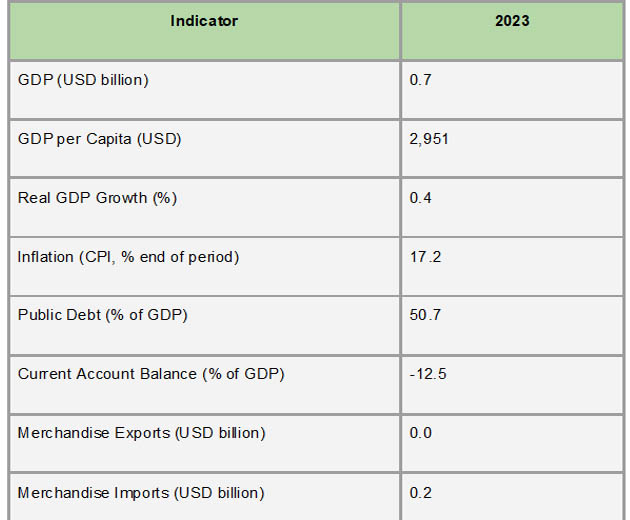
The large amount of public debt and trade deficits, where imports far exceed exports, are other features of the nation's economic structure. São Tomé relies heavily on imports for fuel and food, which strains the country's current account balance. Despite these obstacles, there have been indications of modest economic growth, bolstered by foreign aid and infrastructure development, according to São Tomé and Príncipe Import Custom Data by Import Globals. There are continuous efforts to increase domestic output and enhance budgetary management. São Tomé and Príncipe is striving for long-term sustainability and economic resilience with the help of planned reforms and ongoing assistance from international partners.
Export Data Analysis
Significant changes have occurred in São Tomé and Príncipe's export environment between 2020 and 2024. With cocoa beans and palm oil as the main commodities, the nation's exports were worth about $24 million in 2020. Exports increased somewhat to $22 million by 2022, but in 2023 they jumped significantly to $57.1 million, mostly due to $30.8 million in crude petroleum exports to Pakistan. The country's trade dynamics underwent a significant shift with this diversification into petroleum exports. However, according to Import Globals' São Tomé and Príncipe Import Trade Analysis, shipments dropped to $16.55 million in 2024, highlighting the need for a more diversified export base and suggesting possible volatility in the petroleum sector.
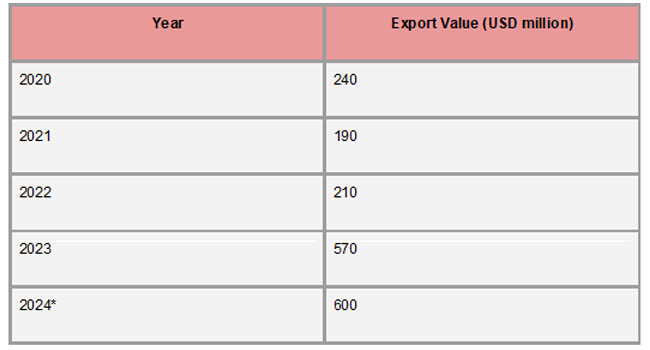
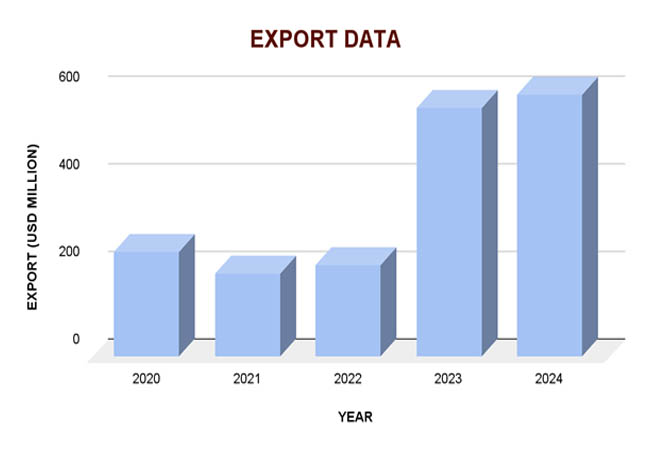
Additionally, the makeup of exports has changed. Even while cocoa beans continued to be a staple, generating $8.73 million in 2023, the export portfolio was drastically changed by the commencement of crude petroleum exports. Palm oil ($3.89 million) and auto parts and accessories ($4.7 million) were two other noteworthy exports. According to Import Globals' São Tomé and Príncipe Export Data, São Tomé and Príncipe's efforts to broaden its trade partnerships are reflected in the rise of new export destinations like Pakistan, Germany, and the United Arab Emirates. Nonetheless, the 2024 export value fall emphasizes the difficulties brought on by an over-dependence on a small number of commodities and markets.
Leading Producing Regions
Fertile volcanic soils and a tropical climate make for perfect crop cultivation, and São Tomé and Príncipe's agricultural production is firmly anchored in its traditional plantation system. Since the 19th century, cocoa production has been concentrated on the island of São Tomé. About 26% of the nation's farmers reside in the Mé-Zóchi District, making it a notable agricultural center. This district is well known for producing coffee and cocoa, which significantly boosts the country's export revenue. Furthermore, the middle and northern parts of São Tomé Island are covered in vast cocoa plantations, indicating the crop's dominance in the nation's agricultural environment, according to São Tomé and Príncipe Export Import Global Trade Data by Import Globals.
Other regions specialize in different crops besides chocolate. Because of its coastal position and plantation tradition, the Caué District, and especially the village of Ribeira Peixe, has a history of producing palm oil, copra, and coconut oil. Despite its smaller size, the island of Príncipe also contributes to the country's agricultural output. Because of its ideal climate, cocoa growing is particularly common there. Together, these many locations support São Tomé and Príncipe's agricultural industry, contributing to the nation's economy and export portfolio, according to São Tomé and Príncipe Import Export Global Data by Import Globals.
Major Export Destinations
The export environment of São Tomé and Príncipe in 2023 was significantly impacted by its trading ties with some important nations. Pakistan became the leading export destination due mainly to substantial crude petroleum exports of $30.8 million. European nations also played a significant role, with the United Arab Emirates bringing in $1.95 million, France $3.11 million, the Netherlands $3.76 million, and Germany $6.2 million. According to Import Globals' São Tomé and Príncipe Import Data, this diversity shows the country's attempts to broaden its trading alliances outside of conventional markets.
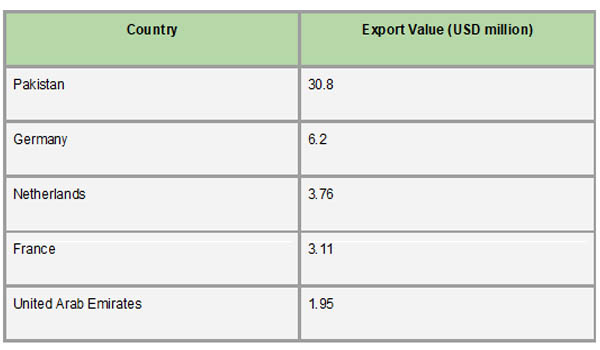
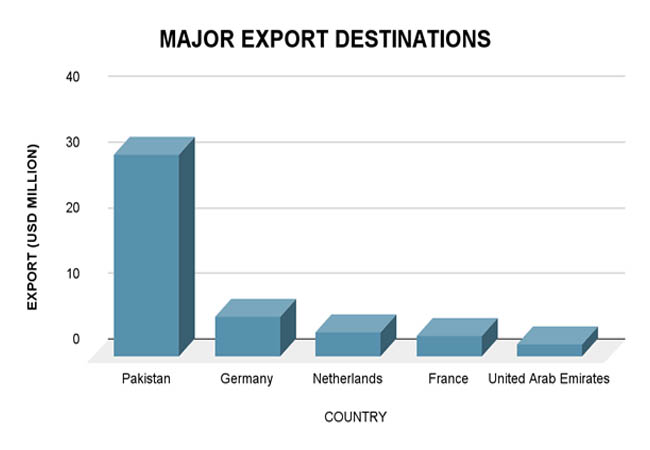
São Tomé and Príncipe's ability to broaden its export portfolio is highlighted by the increase in exports to Pakistan, especially in the petroleum sector. But there are problems because the nation still depends on a small number of commodities and marketplaces. According to São Tomé and Príncipe Import Trade Statistics by Import Globals, São Tomé and Príncipe must invest in value addition, diversify its export goods, and investigate new markets to guarantee sustainable economic growth. The country's economic resilience can be further strengthened by improving the quality of export goods and fortifying trade ties with emerging markets.
Major Product Categories of Sao Tome Exports
Cocoa beans are the main agricultural commodity that drives São Tomé and Príncipe's export-based economy. Whole or broken, raw or roasted, cocoa beans made up around 60% of the country's total exports in 2023, totaling about $10 million. This emphasizes how historically the nation has relied on cocoa as its main export. According to São Tomé and Príncipe Import Shipment Data From Import Globals, palm oil was the second most important export after cocoa, accounting for almost 33% of the total export value, or $5.47 million. In 2023, more than 90% of São Tomé and Príncipe's export revenue came from these two commodities combined.
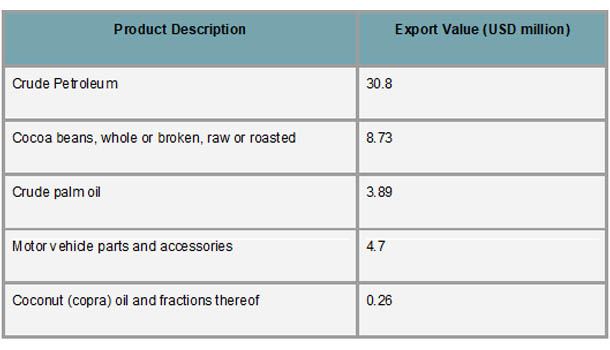
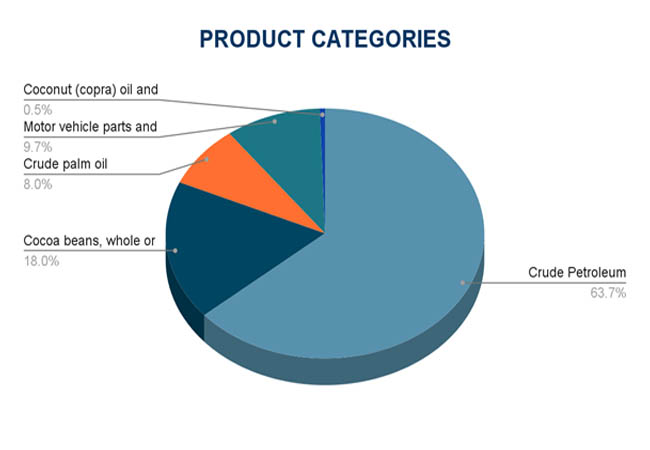
Although in lesser amounts, the nation's export portfolio also consists of a variety of other goods in addition to these mainstays. Among these, coconut oil, coffee, spices, and a variety of tools and technology are noteworthy. Despite making up a small portion of exports at the moment, these categories show possibilities for diversification. Investing in value addition and investigating new markets for these items could improve São Tomé and Príncipe's export resilience and lessen an excessive dependence on a limited product base, according to Import Globals' São Tomé and Príncipe Import Export Trade Analysis.
Strategic Consequences
The export structure of São Tomé and Príncipe, which is mostly dependent on a small number of primary commodities like cocoa and palm oil, offers both advantages and disadvantages. Although the nation has benefited from its natural advantages and agricultural legacy, its limited export base leaves it vulnerable to changes in the global market and climatic concerns. For example, a sharp decline in global cocoa prices or crop failure brought on by unpredictable weather could have a big effect on export earnings. Furthermore, as per São Tomé and Príncipe Export Data, unless backed by long-term resource management and infrastructure improvement, the current surge in petroleum exports in 2023, while encouraging, may not be sustainable. This demonstrates the strategic necessity for the nation to expand its export base and strengthen the value chain of its current commodities through quality enhancement and processing.
São Tomé and Príncipe's location in the Gulf of Guinea, which has the potential to develop into a regional trading hub, is another important strategic factor. By improving port infrastructure and trade logistics, this location might be used to draw in regional trade alliances and foreign investment. Furthermore, São Tomé can gain access to high-end worldwide markets by implementing sustainable and organic farming practices, particularly in North America and Europe, where there is a growing demand for goods sourced ethically. The transformation of São Tomé's export sector from a subsistence-driven economy to a competitive, value-driven trade participant would need strengthening trade contacts, making infrastructural investments, and maintaining political and economic stability.
Forecast Trend
Over the medium term, it is anticipated that São Tomé and Príncipe's export industry will rise gradually and recover somewhat. Exports are predicted to increase after a drop in 2024, propelled by several important reasons. It is expected that the government's emphasis on infrastructure development, energy sector enhancements, and agriculture reforms will increase productivity and lower operating costs. The nation is also well-positioned to gain from regional trade agreements and rising demand for sustainable agricultural products due to its advantageous location on the Gulf of Guinea. According to Trading Economics, exports are therefore expected to increase at a pace of roughly 6.2% each year through 2028, reaching a predicted export value of $0.98 million in January 2025.
It is anticipated that essential commodities like cocoa, palm oil, and crude petroleum will continue to play a major part in São Tomé and Príncipe's export portfolio. Nonetheless, initiatives to diversify are being made to incorporate value-added items and other agricultural products. The nation's focus on sustainable practices and involvement in regional trade initiatives is probably going to expand export prospects and open up new markets. The country's export growth trajectory is anticipated to be supported in the upcoming years by the execution of strategic reforms and international alliances, despite ongoing constraints such as infrastructure restrictions and fluctuations in global markets.
Conclusion
Despite its tiny size, São Tomé and Príncipe's export industry has a lot of room to grow and diversify. The nation has established itself as a major participant in specialized markets due to its reliance on important agricultural products like cocoa and palm oil. However, significant reforms are required to address the problems of global price swings, climate threats, and an excessive reliance on a small number of commodities. São Tomé can improve its economic resilience by concentrating on diversification, making value-adding investments, and growing its trade alliances. Long-term growth and stability of the nation's export industry also depend heavily on its efforts to embrace sustainability and investigate new markets. São Tomé and Príncipe has the chance to establish a more significant position in the international commercial arena with the correct policy changes and infrastructural improvements.
If you are looking for detailed and up-to-date São Tomé and Príncipe Export Data, you can contact IMPORT GLOBALS.
FAQs
Que: What are São Tomé and Príncipe 's principal exports?
Ans: Motor car components, coconut oil, cocoa beans, crude palm oil, and crude petroleum are the primary exports.
Que: Which nations are the most popular export markets?
Ans: In 2023, Pakistan, Germany, the Netherlands, France, and the United Arab Emirates were the biggest export destinations.
Que: How much economic growth is anticipated over the next several years?
Ans: The real GDP is predicted to expand by 1.1% in 2024 and by almost 3.6% in 2026.
Que: What steps is the nation taking to combat inflation?
Ans: With inflation expected to drop to 7.5% by 2026, the Central Bank of São Tomé and Príncipe is tightening liquidity conditions.
Que. Where can to obtain detailed São Tomé and Príncipe Export Data?
Ans. Visit www.importglobals.com or email info@importglobals.com for more information on up-to-date São Tomé and Príncipe Export Data.
